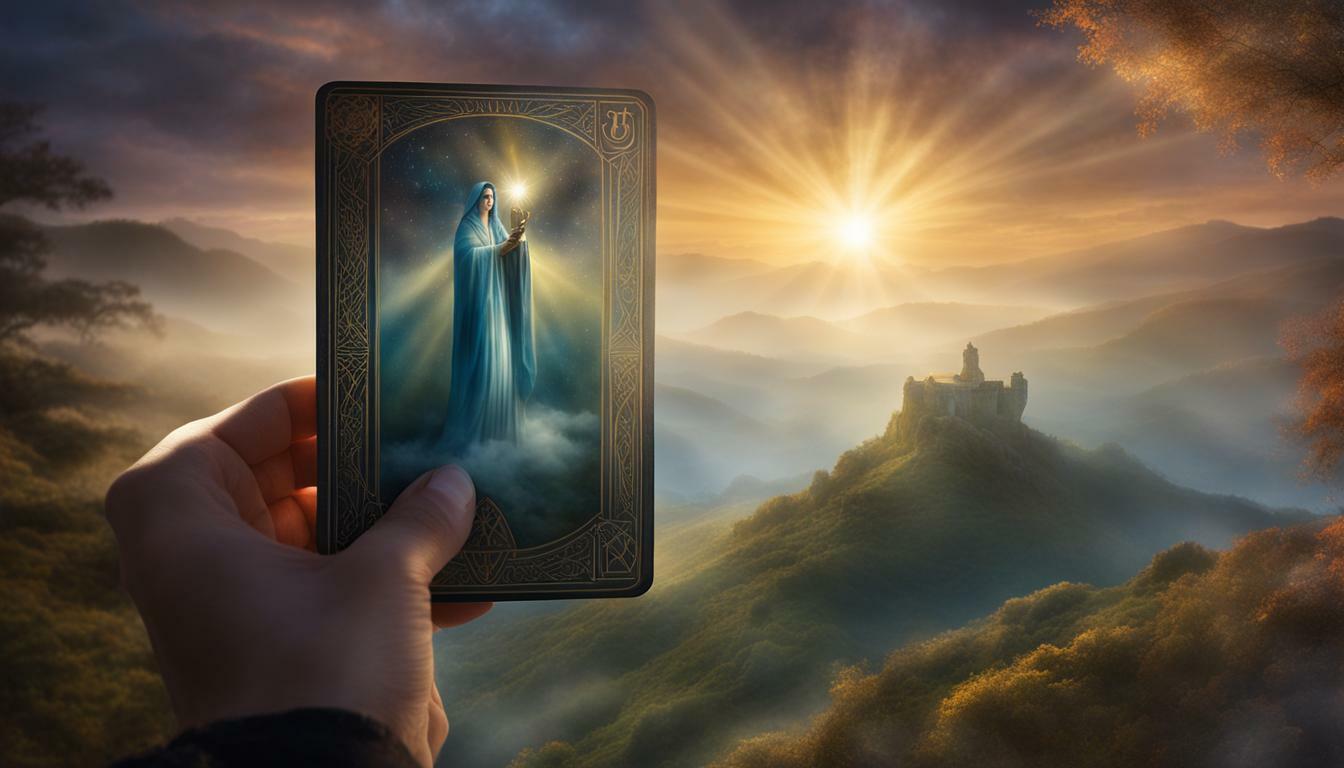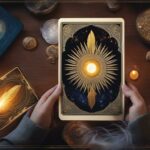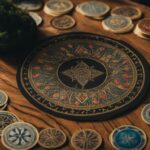Are you ready to delve into the mystical world of tarot cards? Discover how to study tarot cards with our comprehensive guide. Studying tarot cards can be overwhelming at first, but with the right steps and techniques, you can navigate this ancient practice with ease. From choosing the right deck to mastering card selection and interpretation, our guide will equip you with the knowledge and skills to become a confident and intuitive tarot reader.
Key Takeaways:
- Choose a tarot deck that resonates with you.
- Understand the basics of a tarot deck, including major and minor arcana.
- Create a conducive environment for tarot study to enhance the reading experience.
- Practice different methods of card selection and explore various spreads.
- Keep a tarot journal to document your interpretations and insights.
- Develop your intuition and trust your personal connection with the cards.
- Approach tarot with an open mind and embrace the journey of self-discovery it offers.
Choosing the Right Tarot Deck
The first step towards studying tarot cards is finding a deck that speaks to your intuition and personal style. With countless decks available, it’s important to choose one that resonates with you on a deep level. Whether you’re drawn to the traditional symbolism of the Rider Waite deck or prefer a deck with vibrant colors and detailed artwork, finding a deck that you connect with can greatly enhance your tarot card study journey.
Each tarot deck has its own unique energy and interpretation of the cards, so take your time to explore different options. You may find yourself drawn to a particular theme, such as nature, animals, or a specific culture. Trust your instincts and choose a deck that you feel a strong connection with.
Once you’ve chosen your deck, it’s important to familiarize yourself with its structure and symbolism. A tarot deck consists of 78 cards, divided into the major and minor arcana. The major arcana cards represent significant life events and major themes, while the minor arcana cards focus on smaller, day-to-day issues. Understanding the meanings and symbolism behind each card will give you a solid foundation for your tarot card study.
| Major Arcana | Minor Arcana |
|---|---|
| The Fool | Ace of Wands |
| The Magician | Two of Cups |
| The High Priestess | Three of Swords |
| The Empress | Four of Pentacles |
| The Emperor | Five of Swords |
| The Hierophant | Six of Cups |
As you embark on your tarot card study, remember to trust your intuition and approach the cards with an open mind. Experiment with different spreads and card-pulling techniques to find what works best for you. Keeping a tarot journal can also be a valuable tool, allowing you to document your interpretations, track your progress, and reflect on your personal insights.
Remember, tarot card reading is a personal and intuitive practice. Embrace your own unique perspective and develop a deep connection with your chosen deck. With practice and dedication, you’ll unlock the wisdom and guidance that tarot cards have to offer, providing you with a powerful tool for self-discovery and personal growth.
Understanding the Basics of Tarot Decks
Before diving deep into tarot card study, it’s essential to understand the structure and symbolism of a tarot deck. A standard tarot deck consists of 78 cards, which are divided into two main categories – the major arcana and the minor arcana. The major arcana consists of 22 cards that represent significant life events and overarching themes, while the minor arcana consists of 56 cards that address smaller issues and day-to-day tribulations.
The major arcana cards are often seen as the heart of the tarot deck, as they hold powerful symbolism and represent universal archetypes. Each major arcana card depicts a unique image and carries a specific meaning. These cards guide us through major life transitions and offer insight into the deeper aspects of our journey.
The minor arcana cards, on the other hand, are divided into four suits – cups, pentacles, swords, and wands. Each suit represents a different area of life, such as emotions (cups), material possessions (pentacles), thoughts and communication (swords), and creativity and passion (wands). Within each suit, there are numbered cards from Ace to 10, as well as four court cards – the Page, Knight, Queen, and King.
By familiarizing yourself with the structure and symbolism of a tarot deck, you lay the foundation for a meaningful and insightful study journey. Remember that tarot reading is a deeply intuitive practice, and as you connect with the cards on a personal level, their meanings may resonate with you in unique ways.
| Major Arcana | Minor Arcana |
|---|---|
| The Fool | Ace of Cups |
| The Magician | Ace of Pentacles |
| The High Priestess | Ace of Swords |
| The Empress | Ace of Wands |
| The Emperor | Two of Cups |
| The Hierophant | Two of Pentacles |
| The Lovers | Two of Swords |
| The Chariot | Two of Wands |
| Strength | Three of Cups |
| The Hermit | Three of Pentacles |
“Tarot cards are like a mirror, reflecting the depths of your inner self. Take your time to understand their symbolism and let them guide you on your journey of self-discovery.” – Unknown
Exploring the Tarot Decks
- Take your time to choose a tarot deck that resonates with you. Look for decks with artwork and imagery that speaks to your intuition.
- When you acquire a new deck, take a moment to connect with each card individually. Study the details, colors, and symbols, allowing yourself to build a personal connection.
- Some popular tarot decks include the classic Rider Waite deck, the mystical Tarot of the Moon Garden, and the enchanting Wild Unknown Tarot. Explore different options and find the deck that sparks your curiosity.
By understanding the basics of a tarot deck and exploring different options, you pave the way for a meaningful and enlightening study journey. Embrace the symbolism, trust your intuition, and let the tarot cards be your guide as you navigate the path of self-discovery. Happy studying!
Creating the Right Environment for Tarot Study
Enhance your tarot study experience by creating a sacred space that allows you to connect with the cards on a deeper level. The environment in which you study and practice tarot can have a significant impact on your readings and your overall connection with the cards. By implementing effective tarot card learning strategies and creating a conducive atmosphere, you can elevate your tarot practice to new heights.
When it comes to creating the right environment for tarot study, it’s all about setting the mood and cultivating a sense of focus. Consider using specific tablecloths, candles, or incense to create a sacred space that aligns with your energy. These elements can help establish a positive and calm atmosphere that will enhance your ability to tap into your intuition and connect with the cards’ symbolism.
Additionally, it’s essential to eliminate distractions and find a quiet space where you can fully immerse yourself in your tarot practice. This can be a cozy corner in your home, a clear tabletop, or even a designated altar space. Having a dedicated area for your tarot study allows you to create a sense of intention and sacredness, ultimately enhancing your connection with the cards and the messages they hold.
Remember, the environment you create for your tarot study is a reflection of your personal energy and intention. By investing time and effort into creating a space that resonates with you, you will be able to dive deeper into your tarot practice, develop a stronger connection with the cards, and gain valuable insights into your own life and spiritual journey.
| Benefits of Creating the Right Environment for Tarot Study |
|---|
| 1. Enhanced Intuition: By creating a sacred space, you can tap into your intuition more easily, allowing for a deeper understanding of the cards’ messages and symbolism. |
| 2. Increased Focus: A dedicated space free from distractions enables you to concentrate fully on your tarot practice, leading to more accurate and insightful readings. |
| 3. Sacred Connection: A well-crafted environment establishes a spiritual connection with the cards, creating a sacred bond that enhances your ability to interpret their meanings. |
Mastering Card Selection and Spreads
Discover the art of card selection and explore various spreads to gain insights into specific questions and situations. When it comes to choosing cards for a reading, it’s important to trust your intuition and focus on the question or issue at hand. Whether you prefer intuitive pulls or structured spreads, the cards you select will offer unique perspectives and guidance.
One popular method of card selection is the one-card pull. Simply shuffle your deck while keeping your question in mind, then select one card at random. This method is ideal for gaining a general overview or finding guidance for a specific situation.
For a more in-depth reading, consider using a three-card spread. This spread allows you to explore the past, present, and future aspects of a situation. Shuffle your deck, focus on your question, and then draw three cards. Place the first card on the left to represent the past, the second card in the middle to represent the present, and the third card on the right to represent the future. Use the interpretations of each card to gain a comprehensive understanding of your situation.
| Card Selection Methods: | Pros | Cons |
|---|---|---|
| Intuitive Pulls | – Allows for a direct connection with your intuition – Flexible and personal approach to card selection |
– Can be subjective – Requires practice to trust your intuition |
| Structured Spreads | – Provides a clear framework for the reading – Offers specific insights for various aspects of a question |
– May feel restrictive for some readers – Requires knowledge and practice with different spreads |
As you continue your tarot journey, don’t be afraid to experiment with different spreads and card selection methods. The more you practice, the more comfortable you’ll become with interpreting the cards and gaining valuable insights into your life’s questions and situations.
Interpreting Tarot Card Meanings
Unveil the hidden messages within each tarot card as you learn to interpret their meanings and symbolism. As you delve deeper into your tarot card study, you will discover that each card carries its own unique energy and significance. Each symbol, color, and number holds a specific message that can provide insights and guidance for your readings.
Take the time to explore each card individually, noticing the details and symbols present. Pay attention to your initial emotional response and intuitive impressions when you see a particular card. This initial reaction often holds valuable information about the card’s meaning.
As you develop your understanding of the tarot, it is helpful to have resources available to support your interpretation. Tarot card study resources, such as books, online forums, and instructional videos, can provide additional insights and perspectives. These resources can help deepen your knowledge of the different tarot card meanings and provide alternative interpretations that may resonate with you.
| Tip: | Consider creating a tarot card journal to record your interpretations and personal insights. This journal can serve as a valuable reference as you continue to grow and refine your understanding of the cards. |
|---|
Remember, interpreting tarot card meanings is an intuitive process that combines the symbolism of the cards with your own unique perspective. Trust your instincts and allow your intuition to guide you as you explore the messages that the tarot cards have to offer. With time and practice, you will become more confident and attuned to the hidden wisdom that lies within each card.
The Power of Tarot Journaling
Dive into the practice of tarot journaling to document your readings, interpretations, and personal insights. A tarot journal serves as a powerful tool in your study journey, allowing you to track your progress, deepen your understanding of the cards, and uncover patterns and themes that emerge from your readings.
One way to structure your tarot journal is by creating a table to record each reading. Include the date, the question or theme explored, the cards pulled, and any significant impressions or emotions that arise during the reading. By documenting this information, you can revisit past readings, identify patterns, and gain new insights over time. You may even discover recurring symbols or themes that offer deeper meaning to your tarot practice.
| Date | Question/Theme | Cards Pulled | Impressions/Emotions |
|---|---|---|---|
| June 15, 2022 | Career Guidance | The Emperor, Eight of Pentacles, Page of Cups | Feeling a sense of authority and focus in my career path, a desire to develop new skills, and an invitation to explore my creative side. |
| July 3, 2022 | Relationship Insights | The Lovers, Ten of Cups, Two of Swords | Sensing a deep connection and harmony in my current relationship, a feeling of fulfillment and contentment, but also an indication of potential challenges that require careful decision-making. |
In addition to recording your readings, consider using lists and quotes to capture your interpretations and personal insights. Create a list of keywords or phrases associated with each card and annotate them with your own observations and impressions. This allows you to develop a unique understanding of each card’s meaning, incorporating both traditional interpretations and your own intuitive insights.
- The Emperor: Authority, discipline, structure
- Observations: Represents a need for taking charge, establishing boundaries, and maintaining order in my life. Encourages me to embody leadership qualities and embrace structure in my relationships and endeavors.
- The Lovers: Love, harmony, choice
- Observations: Symbolizes a deep connection and emotional harmony. Reflects the importance of making choices rooted in love and authenticity, and the need for balancing personal desires with the needs of others.
Remember, your tarot journal is a sacred space for self-reflection and exploration. Embrace your unique insights, trust your intuition, and allow the cards to guide you on your personal journey of growth and self-discovery.
By incorporating tarot journaling into your study methods, you create a valuable resource that not only enhances your understanding of the cards but also serves as a reflection of your personal growth and transformation. Whether you choose to write or draw in your journal, the act of documenting your readings and interpretations fosters a deeper connection with the tarot and allows you to uncover layers of meaning that may have otherwise gone unnoticed.
Embracing Your Intuition and Personal Connection
Embrace your innate intuition and unlock the true power of tarot cards as you establish a unique and personal connection with each reading. Studying tarot cards goes beyond memorizing their meanings; it’s about tapping into your intuition and developing a personal relationship with the cards. Trusting yourself and your instincts is the key to unlocking deeper insights and receiving accurate guidance.
As you delve into the world of tarot, remember to approach it with an open mind and an open heart. Allow the cards to speak to you in their own language, and resist the temptation to rely solely on external interpretations. The beauty of tarot lies in its ability to connect with your inner voice and guide you on your own journey of self-discovery.
To develop a more personal connection with the cards, consider incorporating rituals and practices that resonate with you. This could include cleansing and consecrating your deck, creating a sacred space for your readings, or meditating before each session. These practices not only enhance the energy of your readings but also help you establish a deeper connection with the cards and your own intuitive abilities.
Remember that tarot cards are tools for self-reflection and self-exploration. They serve as mirrors of your subconscious mind, offering insights that can guide you towards personal growth and decision-making. By embracing your intuition and establishing a personal connection with each reading, you will unlock the true power of tarot cards and gain a deeper understanding of yourself and the world around you.
What Is the Best Method for Understanding Tarot Cards?
Understanding tarot cards can be achieved through various methods. One effective approach is to immerse oneself in the symbolism and story behind each card. Another method involves establishing a personal connection with the deck by conducting regular readings and reflecting on the outcomes. Exploring different interpretations and joining tarot communities can also deepen understanding.
Conclusion
Embark on your tarot card study journey and unlock the mystic world that awaits, gaining valuable insights and wisdom along the way. Studying tarot cards can initially seem overwhelming, but by following a few key steps, you can navigate the process with ease.
Begin by choosing a tarot deck that resonates with you, whether it’s the classic Rider Waite deck or one with vibrant colors and detailed artwork. Understanding the basics of a tarot deck is crucial, as it consists of 78 cards divided into major and minor arcana. The major arcana cards deal with significant life events and overarching themes, while the minor arcana cards address smaller issues and day-to-day tribulations.
Creating a conducive environment for your tarot study can make a significant difference. Consider using specific tablecloths, lighting candles, or burning incense to set the mood. When shuffling and cutting the cards, focus on the question in mind and trust your intuition when selecting the cards.
To pull cards, you can use different methods such as intuitive pulls or specific spreads like the one-card or three-card spread. As you become more familiar with the cards, start learning their meanings. Keeping a tarot journal can be immensely helpful, allowing you to document your interpretations and create your own encyclopedia of card meanings.
Approach tarot with an open mind, trust your intuition, and develop a personal relationship with the cards. Choose a deck that speaks to you and remember to cleanse and care for your cards regularly. Tarot card reading is ultimately a journey of self-discovery and intuition, providing valuable insights and guidance for personal growth and decision-making.








